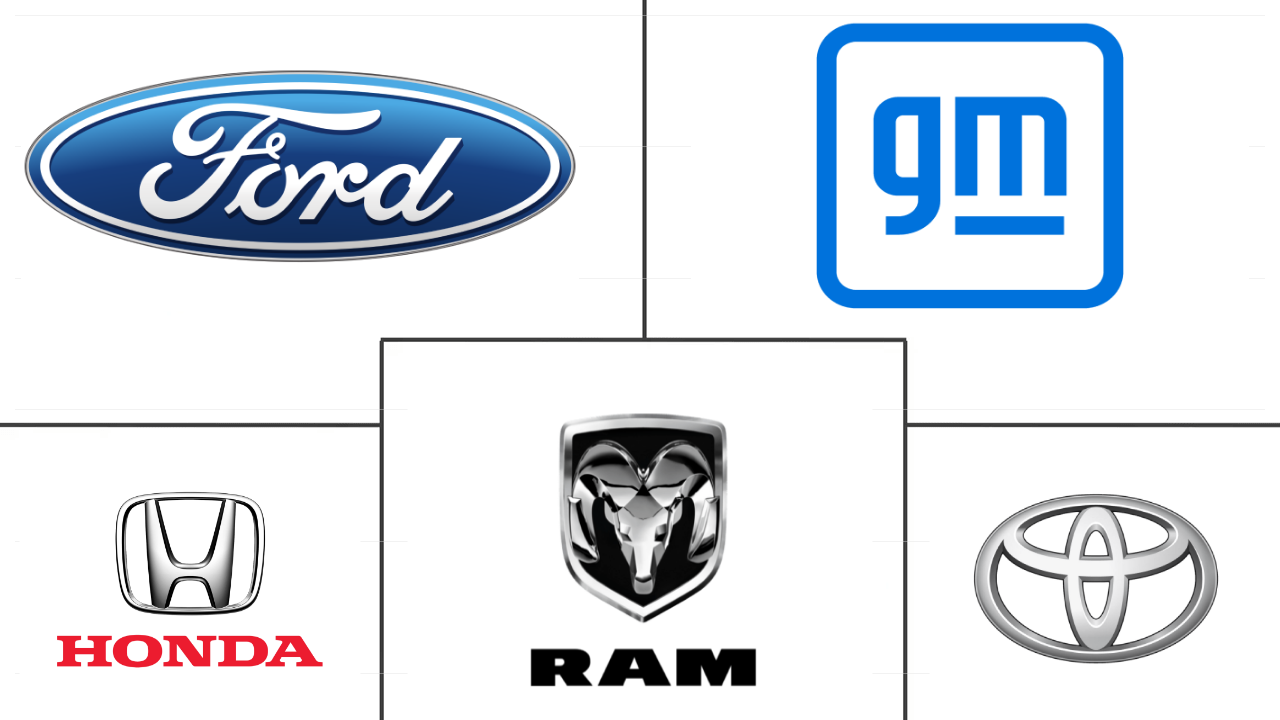Market Size of canada commercial vehicles Industry
| Icons | Lable | Value |
|---|---|---|
|
|
Study Period | 2017 - 2030 |
|
|
Market Size (2024) | USD 23.65 Billion |
|
|
Market Size (2030) | USD 25.78 Billion |
|
|
Largest Share by Vehicle Body Type | Light Commercial Pick-up Trucks |
|
|
CAGR (2024 - 2030) | 1.45 % |
|
|
Fastest Growing by Vehicle Body Type | Buses |
|
|
Market Concentration | High |
Major Players |
||

|
||
|
*Disclaimer: Major Players sorted in no particular order |
Canada Commercial Vehicles Market Analysis
The Canada Commercial Vehicles Market size is estimated at 23.65 billion USD in 2024, and is expected to reach 25.78 billion USD by 2030, growing at a CAGR of 1.45% during the forecast period (2024-2030).
23.65 Billion
Market Size in 2024 (USD)
25.78 Billion
Market Size in 2030 (USD)
-0.51 %
CAGR (2017-2023)
1.45 %
CAGR (2024-2030)
Largest Segment by Vehicle Body Type
76.90 %
value share, Light Commercial Pick-up Trucks, 2023
Light commercial pick-up trucks lead due to their reliability, capacity for heavy-duty tasks, and popularity among trades, small businesses, and for personal use in both urban and rural settings.
Largest Segment by Fuel Category
57.61 %
value share, Gasoline, 2023
Gasoline vehicles dominate because of the well-established refueling network, lower initial vehicle costs, consistent performance in varying climates, and longer driving range.
Fastest-growing Segment by Fuel Category
41.75 %
Projected CAGR, BEV, 2024-2030
BEVs are the fastest-growing segment due to increasing government incentives, expanding charging infrastructure, and advancements in battery technology improving range and affordability.
Leading Market Player
33.92 %
market share, Ford Motor Company, 2023

Ford Motor Company is the largest player due to its extensive range of reliable and versatile commercial vehicles, strong brand reputation, and widespread dealership network across Canada.
Second leading Market Player
17.48 %
market share, Ram Trucking, Inc., Inc.

Ram Trucking, Inc. holds a significant market position due to its robust lineup of durable commercial trucks, high customer satisfaction, and a strong presence in both urban and rural areas.
Canada's diversified commercial vehicle market is catering to a wide range of industrial and logistical needs, focusing on enhancing efficiency and sustainability
- The Canadian commercial vehicles market is characterized by its adaptability to technological advancements and changing regulatory environments. Light commercial vehicles (LCVs), such as vans and pickup trucks, are the backbone of small and medium-sized enterprises (SMEs) in Canada, facilitating a wide range of activities from deliveries and trades to services. The demand for light commercial vehicles is driven by their versatility and efficiency, particularly in urban settings where maneuverability and parking are key considerations. The growing e-commerce industry has notably increased the need for delivery vehicles, thus propelling the demand for light commercial vehicles.
- Medium and heavy-duty commercial vehicles (M&HCVs), including rigid trucks and tractor-trailers, are critical to Canada's logistics and transportation infrastructure, enabling long-haul goods movement across the country and to the United States. The logistics and transportation sector's growth is closely tied to the health of the Canadian economy, with industries like construction, manufacturing, and retail directly influencing the demand for M&HCVs.
- The bus segment in Canada encompasses city buses, coaches, and school buses, serving public transportation, long-distance travel, and student transport needs, respectively. Public transit agencies are increasingly investing in low- and zero-emission buses, including electric and hybrid models, in response to environmental policies and demand for cleaner, more sustainable transportation options from the community.
Canada Commercial Vehicles Industry Segmentation
Commercial Vehicles are covered as segments by Vehicle Type. Hybrid and Electric Vehicles, ICE are covered as segments by Propulsion Type.
- The Canadian commercial vehicles market is characterized by its adaptability to technological advancements and changing regulatory environments. Light commercial vehicles (LCVs), such as vans and pickup trucks, are the backbone of small and medium-sized enterprises (SMEs) in Canada, facilitating a wide range of activities from deliveries and trades to services. The demand for light commercial vehicles is driven by their versatility and efficiency, particularly in urban settings where maneuverability and parking are key considerations. The growing e-commerce industry has notably increased the need for delivery vehicles, thus propelling the demand for light commercial vehicles.
- Medium and heavy-duty commercial vehicles (M&HCVs), including rigid trucks and tractor-trailers, are critical to Canada's logistics and transportation infrastructure, enabling long-haul goods movement across the country and to the United States. The logistics and transportation sector's growth is closely tied to the health of the Canadian economy, with industries like construction, manufacturing, and retail directly influencing the demand for M&HCVs.
- The bus segment in Canada encompasses city buses, coaches, and school buses, serving public transportation, long-distance travel, and student transport needs, respectively. Public transit agencies are increasingly investing in low- and zero-emission buses, including electric and hybrid models, in response to environmental policies and demand for cleaner, more sustainable transportation options from the community.
| Vehicle Type | |||||||
|
| Propulsion Type | ||||||||
| ||||||||
|
Canada Commercial Vehicles Market Size Summary
The Canadian commercial vehicles market is poised for steady growth, driven by its ability to adapt to technological advancements and evolving regulatory frameworks. Light commercial vehicles, such as vans and pickup trucks, play a crucial role in supporting small and medium-sized enterprises by facilitating various activities, including deliveries and services. The increasing demand for these vehicles is largely attributed to their versatility and efficiency, especially in urban areas where space constraints are a concern. The burgeoning e-commerce sector has further amplified the need for delivery vehicles, thereby boosting the demand for light commercial vehicles. Meanwhile, medium and heavy-duty commercial vehicles are essential for the logistics and transportation infrastructure, supporting long-haul goods movement across Canada and into the United States. The health of the logistics sector is closely linked to the Canadian economy, with industries like construction, manufacturing, and retail driving the demand for these vehicles.
The bus segment in Canada, encompassing city buses, coaches, and school buses, is also evolving, with public transit agencies increasingly investing in low- and zero-emission models to align with environmental policies and community demand for sustainable transportation. The shift towards electric vehicles is gaining momentum, supported by government initiatives like the Climate Plan, which aims to increase the adoption of zero-emission vehicles. The government's commitment to reducing emissions has led to significant investments in electrifying commercial vehicles, including trucks and buses, with a target for all heavy-duty vehicles to run on clean fuel by 2035. This regulatory push, coupled with substantial investments, is expected to enhance the demand for electric vehicles across Canada in the coming years. The market is fairly consolidated, with major players like Ford, General Motors, Honda, Ram Trucking, and Toyota dominating the landscape, all of which are actively pursuing electric vehicle innovations to meet future demands.
Canada Commercial Vehicles Market Size - Table of Contents
-
1. MARKET SEGMENTATION (includes market size in Value in USD and Volume, Forecasts up to 2030 and analysis of growth prospects)
-
1.1 Vehicle Type
-
1.1.1 Commercial Vehicles
-
1.1.1.1 Buses
-
1.1.1.2 Heavy-duty Commercial Trucks
-
1.1.1.3 Light Commercial Pick-up Trucks
-
1.1.1.4 Light Commercial Vans
-
1.1.1.5 Medium-duty Commercial Trucks
-
-
-
1.2 Propulsion Type
-
1.2.1 Hybrid and Electric Vehicles
-
1.2.1.1 By Fuel Category
-
1.2.1.1.1 BEV
-
1.2.1.1.2 FCEV
-
1.2.1.1.3 HEV
-
1.2.1.1.4 PHEV
-
-
-
1.2.2 ICE
-
1.2.2.1 By Fuel Category
-
1.2.2.1.1 CNG
-
1.2.2.1.2 Diesel
-
1.2.2.1.3 Gasoline
-
1.2.2.1.4 LPG
-
-
-
-
Canada Commercial Vehicles Market Size FAQs
How big is the Canada Commercial Vehicles Market?
The Canada Commercial Vehicles Market size is expected to reach USD 23.65 billion in 2024 and grow at a CAGR of 1.45% to reach USD 25.78 billion by 2030.
What is the current Canada Commercial Vehicles Market size?
In 2024, the Canada Commercial Vehicles Market size is expected to reach USD 23.65 billion.

